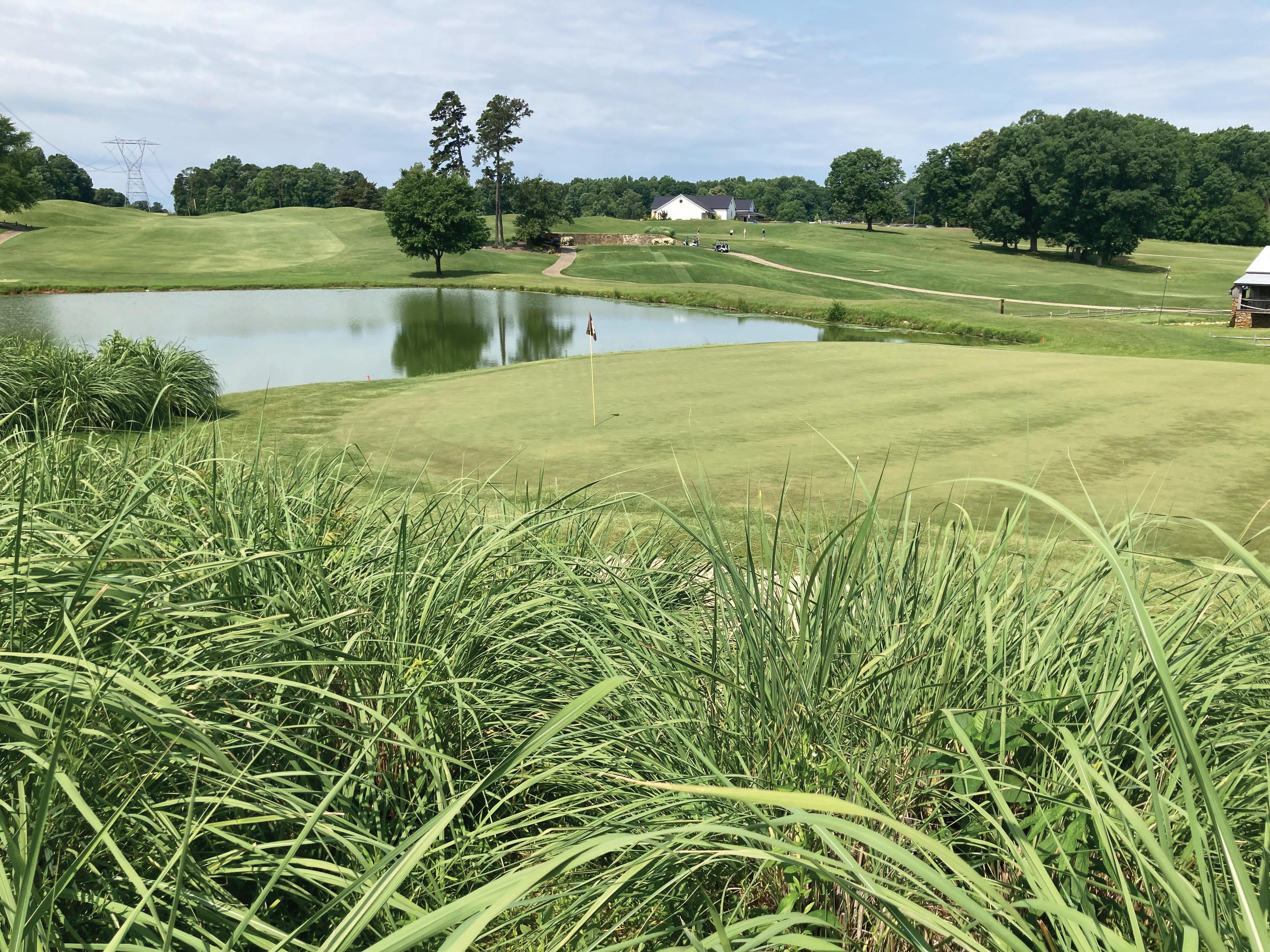
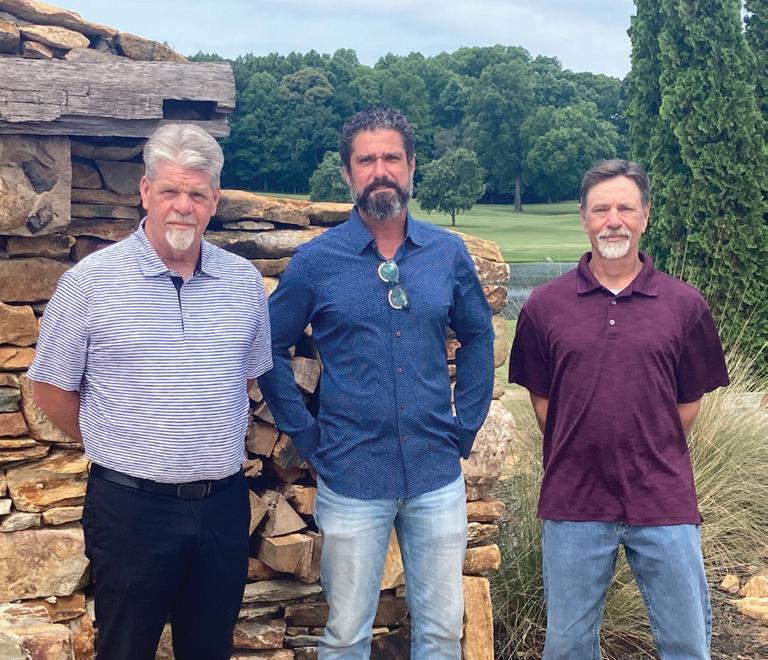


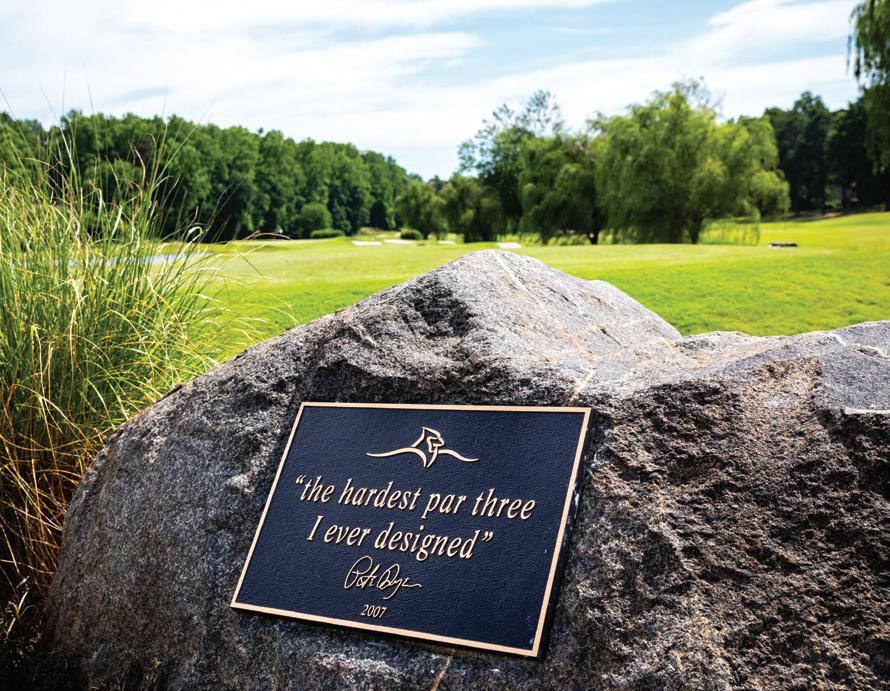

from the editor







from the editor

Golf is booming — at least in popularity.
Don’t believe it? Just try getting a last-minute morning tee time at your favorite Triad course, let alone on a weekend.
Fees at Triad public courses that were around $35 before the COVID-19 pandemic now regularly top $50. Nationally, golf fees were up 29.2% as of February, according to the National Golf Foundation. Golfers are paying the higher prices and adjusting to premium or “dynamic” pricing, especially for high-demand tee times
But course operators aren’t exactly raking in profits. Reports show steep increases in costs—from fertilizer prices doubling to rising energy and labor expenses.
Meanwhile, few if any new public courses are being built. The last new course to open in the Triad was Tot Hill Farm—in 2000. That’s right, 24 years ago.
It’s telling that even with such high demand, no new inventory is being created. Perhaps that’s the clearest sign the industry needs to evolve.
Housing and commercial developments are far more profitable for landowners than golf. Luke Hollingsworth, owner of Holly Ridge Golf Links in Archdale, is working to change the model—and it’s paying off. Now, he’s trying to share his Tee Caddie system with other properties.
Our cover story explores several innovations Hollingsworth has implemented at Holly Ridge— from a revamped online tee time platform to alternate revenue sources like a golf simulator lounge, an expanded food and beverage program, and even hosting occasional live concerts.
As much as many traditionalists want the game to remain unchanged, some operations must become more efficient—and more creative—if public golf is to remain viable. Diversifying revenue is no longer optional.
Elsewhere in the Triad, Greensboro National Golf Club (page 15) is offering 12-hole rounds, smart alternative to nine or 18, made possible by routing that finishes No. 12 near the clubhouse.
At the high end of the spectrum, destination resorts in Oregon, Missouri, Nebraska, and Wisconsin are thriving. Pinehurst Resort has added one course and is building another. Some area private clubs now have waiting lists, with many recently completing high-dollar renovations. Golf is clearly booming.
But if surging demand doesn’t translate into lasting profitability for public courses, what happens when business inevitably levels off?
The industry must be ready to adapt.
John Brasier
ON THE COVER
Main: Holly Ridge Golf Links. (inset) Tee Caddie partners (from left): Chris Sidden, Luke Hollingsworth and Jacob Shouse.
JOHN BRASIER Editor + Publisher | john@triadgolf.com
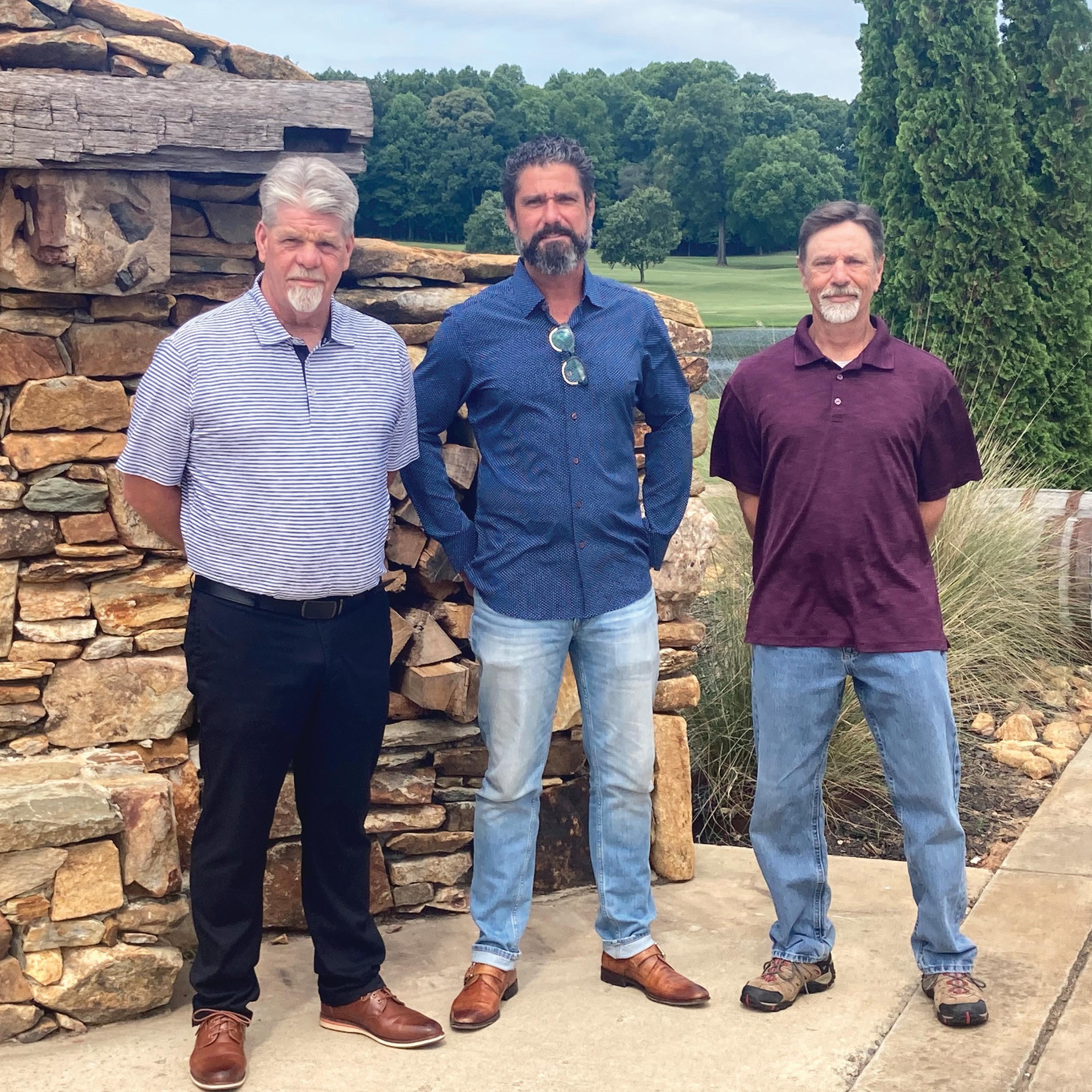
Holly Ridge Golf Links does things differently than most public golf courses – from the online booking of an exclusive tee time through the 19th hole service provided by robots in a leather sofafilled lounge surrounded by golf simulators.
That’s because when Luke Hollingsworth took over as sole owner in 2007, the golf course business wasn’t booming as it is in the postCovid 19 era.
The U.S. economy was stuck in recession and the housing bubble was about to burst. With play down at U.S. courses, Hollingsworth was looking for answers to increase efficiency and revenue at Holly Ridge.
“It was all out of necessity to sustain the business. That was the main catalyst,” said Hollingsworth, whose father Dale opened the course with partners Phil Ridge and Bobby Myers in 1994. “I’ve always been one to do things different. I don’t understand why everyone wanted to be like everyone else. I believe that in business you have to do things to make yourself stand out.”
Convinced that he did want to remain in the golf business, Hollingsworth took on the challenge when his father’s partners wanted to sell. He sought new, better ways to do business.
Eventually, Hollingsworth created Tee Caddie, a tee sheet platform that sells tee times, not individual rounds, and is supported by targeted digital marketing.
“I told my dad, ‘I don’t know anything else I’d rather be doing,” Hollingsworth said.
Hollingsworth has made it work. Revenues are up close to 200% in the five years since Tee Caddie debuted.
Though the pandemic created some initial demand in 2020, Holly Ridge has continued to grow revenues at a similar rate each following year.
Foremost among the business solutions Hollingsworth found was a different way to book golf – sell tee times rather than single rounds.
Led by partners Chris Sidden and Jacob Shouse, Tee Caddie developed technology to maximize efficiency from marketing and booking times and integrating each into a proprietary POS system.
Another major additional revenue source (non-weather dependent) is the spacious Bunker Lounge filled with six simulators (golf and other games), comfy sofas and tables, and a menu including steak, brisket and salads brought to the tables by robots.
“We’re not totally a golf course. We’re in the entertainment business,” Hollingsworth said. “There’s a lot of cookie-cutter courses where everything is the same. I think golf has been stuck with blinders for 100 years.
“In my opinion, instead of bettering what they have and making themselves stand out, owners were just kind of grasping at straws instead of focusing on what they had and creating revenue streams.”
With Tee Caddie, Hollingsworth put himself in prime position to capitalize on the recent boom. The exponential growth in revenues has continued post-pandemic.
“Since 2022, we’re still climbing,” Hollingsworth said. “I have to assume that’s due to reinvestment in course and the tech that we do.”
Now, Hollingsworth and partners are offering Tee Caddie – complete
“I think the golf industry has been charging for golf incorrectly.”



with the fully integrated, proprietary POS system and social media advertising -- to other courses.
Before launching Tee Caddie, Hollingsworth was frustrated by the lack of efficiency with the traditional way golf is sold.
According to the USGA, the average group at a U.S. course includes only 2.6 – not 4 – players, leaving a 35% gap between actual and potential revenue for greens fees and carts in the traditional method of booking per round.
“I think the golf industry has been charging for golf incorrectly,” Hollingsworth said. “Do we need a rate for a single round of golf? Absolutely! But a golf courses’ main inventory consists of tee times, not rounds.
“Think about it like this: Look at any tee sheet in the world. What is on that sheet? Tee times, not rounds. When solicitors come asking for a charitable donation, what do they ask for? A foursome of golf, which is in essence a tee time.
“Other third-party vendors that golf courses use require tee times (not rounds!) for their services. So, if tee times are what we have in our inventory and tee times are what other people and businesses are asking us for, why in the world are we not selling them?”
Selling by the tee time also has benefits for players.
“A lot of people get confused and think it is strictly a “foursome” rate,” Hollingsworth said. “That is completely false – it’s a “tee time” rate. While foursomes obviously get the better deal financially, it also caters to the folks that don’t want to be paired up.
“Once the tee time is purchased, it is out of inventory, so there is no need to try and pair up singles and twosome with others. In other words, if you purchase a tee time instead of a round, that time slot is yours. Bring whoever you like, as many as you like (up to four) and there’s no worry about someone being paired with your group.
“If you want to purchase a single round of golf then you are subject to being paired. That’s the difference between selling rounds and tee times.”
Hollingsworth, who started as superintendent at Holly Ridge after earning a degree in agronomy at N.C. State, said he began considering switching to tee time pricing as early as 2011 or 2012.
Though unique to the Triad and most of the U.S. market, selling golf online by the tee time is standard practice in the United Kingdom.
With Tee Caddie, Hollingsworth said Holly Ridge averages about 3.4 players per tee time, as opposed to the 2.6 national USGA average. He also stated that 90% of his weekend times are Tee Caddie online bookings. Additional threesomes and foursomes also produce more revenue from merchandise and food and drink sales.
Paying online in advance takes away headaches course owners typically suffer from traditional phone reservations that tie up staff, and if not pre-paid, leave course owners vulnerable.
Some golfers will call multiple courses to reserve times, then make their choice without cancelling the others.
“Another benefit I’ve seen is that by requiring booking online, noshows are no longer an issue, and you don’t have groups booking four players and showing up with only two players,” Hollingsworth said.
How does a Tee Caddie partnership work? Tee Caddie doesn’t charge partner courses’ a fee up front. Instead, a revenue target is set considering the number of POS systems the course requires.
Tee Caddie offers multiple pricing strategies to fit the golf courses’ overall goal.
Initial Tee Caddie partners include Siler City Country Club, Monroeton Golf Club in Reidsville and Hedingham Golf Club in Raleigh, courses managed by Dail Golf, a company founded by longtime Triad superintendent Geoff Dail.
“Dail Golf has been an excellent early partner because they recognize the need of effective golf course management services and rely on the Tee Caddie technology to help their managed courses succeed,” Hollingsworth said.
Though focused on adding courses in the central NC markets,

Hollingsworth also has ongoing discussions with other potential users in different regions of the country.
Sidden and Shouse, the technology team for Tee Caddie, are hardware and software technology veterans from Winston-Salem.
Tee Caddie uses targeted Meta ads to drive players to the booking platform. With a course website and the Meta campaign ads as the primary methods for booking times, the effectiveness of the campaigns can be accurately measured.
Tee Caddie includes the fully managed marketing services for all participating courses. Hollingsworth and his technology team believe Tee Caddie is an attractive alternative to the “800-pound Gorillas” that dominate online tee time booking platforms.
“Tee Caddies’ platform is a movement that’s more than just software,” said Sidden. “It’s a declaration of our commitment to reclaim your golf course and your time. It’s your key to regain control of your customers and your tee times. Harness it alongside our managed marketing system, and the reins are back in your hands.”
“It’s essential to recognize that the third-party vendors’ primary customer is the golfer, not the golf course owner,” Sidden said. “Tee Caddie presents a unique opportunity for golf course owners to reassess their marketing strategies and consider discontinuing the use
of barter in favor of a true golf management platform.”
In the competitive landscape of attracting new customers, Tee Caddie lightens the load for pro shop managers by seamlessly handling the intricacies of online advertising. The unique platform covers everything from crafting engaging content to the dynamic publication of live ads, showcasing a campaign strategy that delivers more golfers to the course.
Tee Caddie is about more than Tee Times. It also provides efficiency utilizing the latest technology with an element of fun.
Tee Caddie has teamed with a Canadian golf course management systems provider, Visual Touch (VT) Golf, to employ a tee sheet that also effectively integrates tee times, merchandise, food and beverage (including on-course drink carts) into a single computerized POS system.
Tee Caddie has exclusive U.S. rights to the VT Golf platform. With VT Golf, every POS is connected.
Utilizing the technology, there’s only limited need for staff in Holly Ridge’s Bunker Lounge, where two robots from VT Golf deliver food and clear tables. The kiosk in the lounge will provide a direct method of sending orders to the kitchen. The robots help the staff to keep the
focus on the customer experience.
“People love the robots,” said Hollingsworth. “I think some people come in just to see them.”
As Hollingsworth points out, Holly Ridge doesn’t look like the typical public golf course.
The front door of the modern, but rustic-in-décor clubhouse opens into an attractive full-service bar with comfortable stools. A new pro shop is further right, around a corner. The hallway to the left opens into the Bunker Lounge. An outdoor deck with tables and seating is in the back, overlooking the course and driving range.
An open layout where wind and water protect par features smooth, Ultradwarf Bermuda greens and well-maintained fairways. Old whiskey barrels identify the tee on each hole. Carts are equipped with GPS providing yardages.
The 6,790-yard course is solid with a 72.4 rating and 140 slope from the back tees. Last year, it served as host for the Carolinas Golf Association’s North Carolina Senior Amateur.
The driving range is included for players with a tee time. In addition to daily lunch, the bar and grill serves dinner on Thursday, Friday and Saturday. The clubhouse also hosts an occasional concert.
The facility is frequently booked at night for weddings and other social gatherings.
Hollingsworth was quick to go all-in on simulators -- popular entertainment for social occasions and perhaps the best revenue source during inclement weather.
When rounds are canceled due to lightning or heavy rain, the course offers the simulators as one alternative to a rain check.
“With simulators, we’ve created a whole new base of customers,” Hollingsworth said.
Located off an isolated stretch of U.S. 311, Holly Ridge has become a golf, food, and entertainment destination for the surrounding area. Ø
For more information about Tee Caddie, contact: Luke Hollingsworth | luke@teecaddie.info | 336-442-0281; Chris Sidden | chris@teecaddie.info; Jacob Shouse | jake@teecaddie.info teecaddie.info


Crooked Tree Golf Course In Browns Summit Scan the QR with your phone to access the sign up form.

JULY 26-27
36 Holes Individual Stroke Play.

Open to Amateurs with their U.S.G.A. Amateur status age 16 and above.
The Championship will have (2) Divisions:
Open Division for age 16 as of July 26, 2025 and above (approximately 6,800-6,900 yards)
Senior Division for age 55 as of July 26, 2025 and above (approximately 6,200-6,300 yards)






Weekday $35
Senior Weekday $30
Weekends $40
9-hole rates (weekdays + weekend afternoons)
Walking Allowed Anytime
Jackson Spires of Apex captured the 69th North Carolina Amateur Championship on Saturday at The Cardinal by Pete Dye, finishing with an even-par 70 for a 9-under total of 271 and a two-shot win over UNC’s Mykhailo “Misha” Golod.
The victory earns Spires, 30, an automatic berth in the U.S. Amateur at The Olympic Club in San Francisco.
“I had chills walking off 18,” said Spires. “I’ve never been to California. It’s going to be real cool.”
Golod, 18, fled Kyiv after Russia’s 2022 invasion and now plays for UNC. Spires, a former ECU golfer, is married to a native of Moscow. The two chatted amicably throughout their round.
“It’s not about the people—it’s the governments,” Spires said.
Golod cut a five-shot deficit to two at the turn and made eagle on 15, but Spires answered with a two-putt birdie and then drained a 15-foot birdie at 16 to seal it. He closed with tap-in pars on the final two holes.
A U.S. Mid-Amateur competitor last year, Spires balances golf with a finance job and said he worked partial days during the tournament.
Colby Hutchens (65) and Chad Wilfong (68) tied for third at 275. Branden Boyce finished fifth at 276. Sam Davidson (66) joined a group tied at 278, including first-round leader Cyrus Stewart.
The CGA set up Sunday’s final round for scoring, moving tees forward and selecting accessible pins. Spires and Golod both shot 34 on the back nine.
“We wanted some excitement, and I think that did happen,” said CGA Executive Director Andy Priest. Ø
Thank you to the courses that help make Triad Golf Magazine possible. Please support them in return—play a round, grab a bite, and see why they’re among the best in the region.

5700 Cardinal Way, Greensboro cardinalgolf.com | 336-668-2749
18 Holes • Semi-Private • Par 71 • 7,002–4,904 yards
A McConnell Golf property with limited public access, The Cardinal offers a country club experience on a challenging Pete Dye layout.

330 Niblick Drive, Summerfield greensboronational.com | 336-342-1113
18 Holes • Public • Par 72 • 6,806–4,715 yards
Greensboro National blends rural charm with quality golf. The emphasis on pace-of-play make it a favorite for daily-fee players and league regulars alike.


7041 East Fork Road, Jamestown jamestownparkgolf.com | 336-454-4912
18 Holes • Municipal • Par 72 • 6,665–5,035 yards
A straight-forward municipal gem with strong facilities, walkable terrain, and reshaped Tif-Eagle greens that offer a smooth, honest roll.

200 Country Club Blvd., Lexington lexingtongolfclub.net | 336-248-3950
18 Holes • Municipal • Par 71 • 6,116–4,357 yards
This historic Davidson County favorite offers great value and strong conditions on a hilly, tree-lined course with new Bermuda greens.
2391 Reynolds Park Road, Winston-Salem cityofws.org | 336-727-2703
18 Holes • Municipal • Par 70 • 6,534–4,725 yards
Winston-Salem’s Reynolds Park is a rolling municipal layout with scenic elevation changes, well-kept fairways, and strategic bunkering. With a relaxed vibe and walkable terrain, it’s a great value for everyday golfers.


Greensboro’s Mallory Pitts fired a finalround 70 on Thursday to win the 69th Carolinas Junior Girls’ Championship by two strokes at WildeWood Club in Columbia, S.C.
Pitts, 15, and a rising sophomore at Greensboro Day School, finished at even-par 216 for the 54-hole event. Her final round included five birdies and just three bogeys, including one at the 18th with the title in hand.
Jenna Kim of Raleigh finished second after a closing 71. Pitts, who started the day three shots back, made key birdies on two par-5s and stayed steady throughout.
The families behind Pine Needles and Mid Pines have announced a new partnership with Marine & Lawn Hotels & Resorts, which will take over management of both properties and lead renovations of their hotels and food-and-beverage operations.
The Miller, McGowan, and Tharani families—owners of Pine Needles, Mid Pines, and the recently acquired Southern Pines Golf Club—are steering the historic resorts into their next chapter.
“This is an exciting initiative for our resorts,” said Kelly Miller, president and CEO, in a release. “We’ve needed for some time to upgrade our lodging facilities as well as our food and beverage, and Marine & Lawn is an ideal partner for us.”
Marine & Lawn brings a strong track record of high-end hospitality at iconic golf destinations. Its international portfolio includes Rusacks St Andrews, Marine North Berwick, Marine Troon, and Dornoch Station in Scotland, as well as Slieve Donard near Royal County Down and Portrush in Northern Ireland.
The renovation work will begin this fall at Mid Pines, which will be shut down for six to eight months. Plans call for golf operations to continue uninterrupted throughout the hotel renovations. Ø
“I was hitting the ball well today… Everything overall was just consistent,” Pitts told the Carolinas Golf Association. Ø
The Dugan Aycock Davidson County Amateur is accepting registrations for the July 26-27 tournament at Lexington Golf Club.
The 36-hole, stroke-play tournament is open to all amateurs 16 and over. The field will be flighted after the first round. Tee times begin at 7:30 a.m. each day off the first tee.
Players do not have to live in Davidson County to play. Registration can be made in person at the Lexington Golf Club pro shop or by calling 336-248-3950.
Players must be 16 years and older. A Senior Division is open to players 55 and older.
Davis Womble
The entry fee is $75, plus golf fees each day. Ø
Don’t have the time or stamina for 18 holes? But does playing just nine not quite justify putting on golf clothes and driving to the course?
One Triad golf course has introduced a unique solution.
Greensboro National Golf Club in Summerfield began offering a 12-hole round in early May—an option now available alongside its standard nine- and 18-hole rounds on the facility’s online tee sheet.
General manager Bruce Mohler said the course saw a record financial month in May, with 12-hole rounds accounting for 12 percent of total rounds played.
“So far, so good,” Mohler said. “It’s been really well-received. It just made too much sense.”
The best part? Nine- and 18-hole rounds also increased during that time, suggesting minimal cannibalization of 18-hole rounds—the most profitable format.
Mohler said feedback indicated many golfers were willing to commit the time for 18 holes, but felt that playing just nine wasn’t worth the trip to the course. So he and head golf professional Chase Dubin explored new options.
“If golf were reinvented, 14 or 15 holes would be about right,” Mohler said. “It’s either nine or 18. Why? Chase and I have been talking about this for a long time.”
So how much does 12 holes cost? Because Greensboro National uses dynamic pricing, rates vary, but Mohler said the 12-hole option is priced between the nine- and 18-hole rates—closer to the latter.
Mohler, who came to Greensboro National more than two years ago after a long career in the Jacksonville, Florida, area, said a course in that market offered three-hole packages thanks to creative routing, where each three-hole loop ended near the clubhouse.
Greensboro National’s own routing made 12 holes a natural fit, with the green on No. 12 located just across the street from the clubhouse.
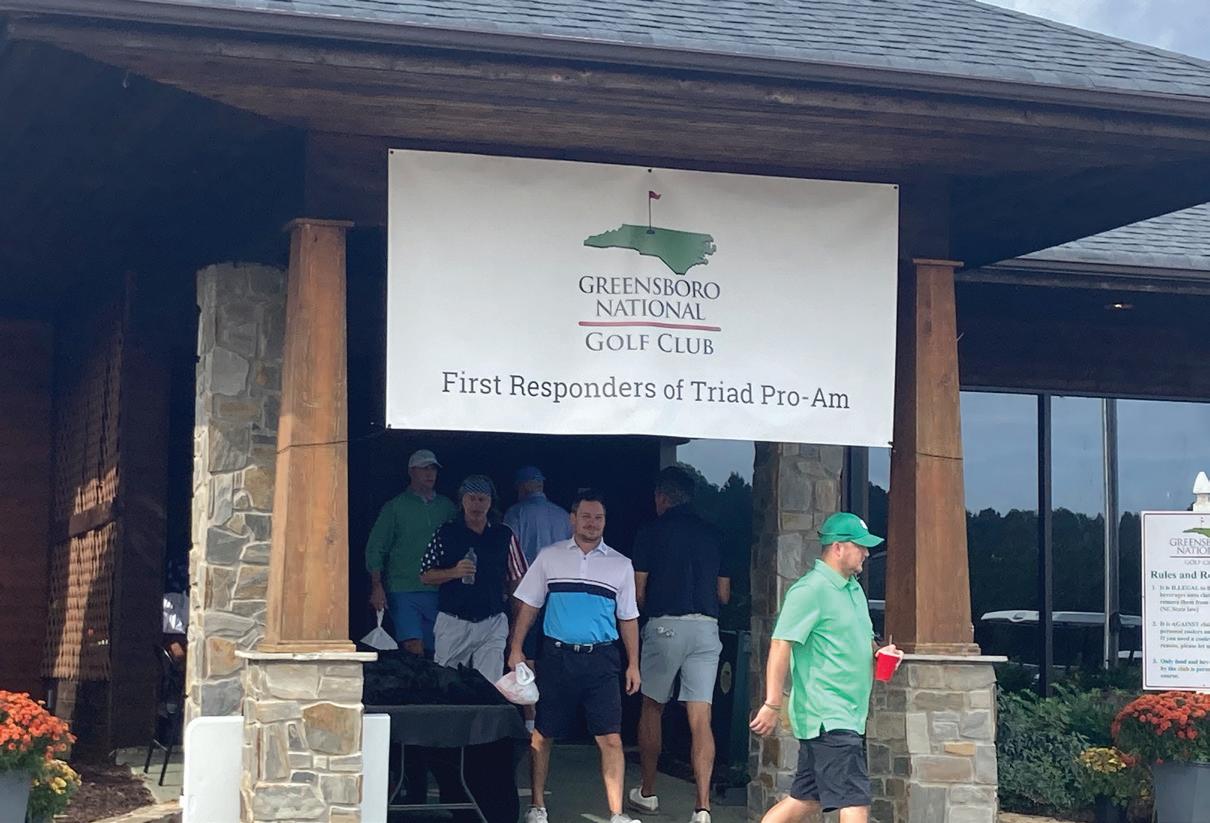
To support the new format, the GPS system that governs the golf carts required updates—creating geofences to limit access to non-authorized areas, including the parking lot, which has been off-limits since the course introduced complimentary drive-up bag service.
Carts used for 12-hole rounds are now permitted to return to the clubhouse after the 12th hole—but are blocked from accessing the 13th tee. Mohler said he and Dubin briefly considered launching a six-hole option starting at No. 13, but logistical challenges ruled it out.
Mohler expects most 12-hole rounds to be played by casual, social golfers—particularly in the afternoon or early evening. More serious players, especially those who frequent the high-demand morning weekend tee times, are likely to stick with the traditional 18. Ø

Neither an errant iron shot to the head nor a weather-shortened state final could keep Brandon Bowman from leading Mt. Airy High School to the NCHSAA Class 1A boys’ golf championship.
Bowman’s dramatic postseason began at Roaring Gap Club during the Northwest 1A Conference tournament.
Standing in high grass “15 yards” from the No. 3 tee markers and gazing down the fairway of the short, dogleg-left par-4 with his rangefinder, Bowman never saw the practice backswing from Elkin’s Alex Garza that crashed into the side of his head and knocked his cap off.
“’What was that?’ I thought,” recalled Bowman, stunned by the unseen blow. “Then I look over, and he’s about to do it again.”
Like Bowman, Garza must have assumed he was a safe distance from his competitors. Bowman said Garza, whom he now jokingly calls “headhunter,” apologized multiple times.
Though he avoided a second swing, Bowman admits he was “dizzy” for several holes after getting hit—he never did find out what iron struck him—and developed a large knot on his head.
Initially, Bowman seemed to shake it off. But soon after, he became queasy and asked his mom for a soft drink to help settle his stomach. Eventually, he vomited behind the bushes at No. 5. At No. 7, he hit a shot out of bounds and made double bogey.
That’s when Mount Airy coach Mark Hiatt checked in to make sure Bowman was well enough to continue. They agreed to make a decision at the turn.
Bowman bounced back with birdies on Nos. 8 and 9, and finished with a 73 on the tough Donald Ross design. Most importantly, he escaped serious injury.
“That’s a pretty good comeback,” said Bowman, who was examined the next day and did not suffer a concussion. “The doctor said an inch in another direction and I would have been hit in the temple.”
The Granite Bears, regular-season Northwest champions, finished second to Elkin in the conference tournament. But a state title was still within reach.
At the 1A Midwest Regional, Bowman and Mount Airy rebounded. Bowman earned medalist honors with a 1-under-par 71 at Cedarbrook Country Club, leading the Granite Bears to a two-shot win over Union Academy.
In the state championship at Longleaf Golf & Family Club in Southern Pines, heavy rain plagued the first round. Bowman and the Granite Bears slogged through eight holes—Bowman was 4-over—before play was suspended.
Comparing conditions to a monsoon, Bowman said the rain was so intense he couldn’t even see through his rangefinder.
With the tournament shortened to 18 holes, Bowman got off to a rough start the next day, making a bogey and a double bogey on his first two holes. At that point, he was 8-over after 10 holes and sitting somewhere “in the 60s” on the leaderboard.
“I told myself, ‘Bear down and make something happen,’” said the longhitting Bowman, who knew he could take advantage of two remaining par-5s.
He did just that. With three birdies—two of them on par-5s—over his final eight holes, Bowman carded a 76 and tied for fifth in the individual standings. Though he didn’t check the live leaderboard on his phone, Bowman was later told that his birdie on the 16th hole gave Mount Airy the lead for good.
Shockley Hiatt added an 80, Oscar Stanley posted 81, Will Bowman shot 83, and Finley Baird recorded 88 for the Granite Bears—the only public school team to finish in the top six.
Sawyer Slate of South Stokes won medalist honors at Longleaf with a 71.
Bowman has been accepted into Campbell University’s PGA Golf Management program and plans to stay five years to earn his MBA. He turned down several offers to play college golf elsewhere.
“I don’t think I’m good enough to go to the PGA Tour,” he said.
Instead, he hopes to combine his interest in mechanical engineering with his passion for golf—possibly working for a major club manufacturer.
“If I could get an internship at Titleist, that would be cool,” Bowman said. “That would be my No. 1.” Ø




The approach at No. 9 must carry a lake, leaving a long, uphill approach.
Howdid a small town manage to build a challenging, well-maintained golf course with 18 holes and a driving range?
“It literally was built with booze and liquor money,” said Scott Coakley, longtime parks and recreation director for the Town of Jamestown.
Back in 1974, Jamestown (population 2,231 according to the 1970 Census) had a thriving ABC store located near the border of then-dry High Point. Revenue was pouring in—more than the town could spend.
According to Coakley, state officials told Jamestown it needed to start using some of those funds. He says he’s seen the original state grant request, which listed ABC revenue as the source of matching funds.
With that, the town pieced together 180 acres—some of it acquired in a land swap with High Point—and built Jamestown Park Golf Course.
The result is a big-time municipal facility in a town that still has fewer than 4,000 residents. Most of the course is free of surrounding housing, and its TifEagle Bermuda greens are among the fastest in the Triad.
The par-72 layout stretches to 6,700 yards from the back tees with a course rating of 72.4 and a slope of 129. Three other tee boxes are available, starting at under 5,000 yards.
Jamestown has committed to keeping the course in top condition. All staff are full-time town employees—no third-party management company has ever been involved.
“Jamestown has always taken pride in this place,” Coakley said. “We’re a small community with an 18-hole course and a driving range. I believe we might be the smallest town in the country to offer that.”
The original John Townsend design received a greens renovation in 2016 by architect Lester George. He softened some of the contours to allow for more pin placements and replaced the bentgrass greens with the more durable TifEagle Bermuda.
Only about 6% of the course’s annual rounds are played by Jamestown residents, who do receive a discounted rate. Still, the course hosted 33,000 rounds last year. Rack rates for 18 holes with cart are $45 on weekdays and $55 on weekends.
“Honestly, word of mouth is important,” said head professional Marcy Newton. “The greens are good—we hear that all the time. Our greens rival some of the country clubs.”
Much of the course’s difficulty comes from undulating fairways lined with mature trees. Water hazards are limited, but they’re strategic— especially at holes like the par-3 17th, where a forced carry is required to reach a green sloping back toward a lake.
The par-4 9th is among the course’s most demanding, with a mediumlength tee shot required to carry a lake to an uphill fairway that bends slightly left toward the clubhouse.
Still, many greens allow players to run the ball up, and the bunkers, while well-placed, aren’t especially deep.
“I’d say we get all types of golfers—from beginners to scratch,” Newton said. “The course is good in that way.”
The signature hole is likely the par-3 8th. Playing just under 200 yards from the tips, the hole rises uphill to a green with a significant hump on the right. Trees line the tight right side, while a deep front-left bunker and steep slope catch errant shots. Just a few paces beyond the green lies out-of-bounds.
Most of the course’s par-4s and par-5s bend slightly to the left, giving rise to a bit of local lore.
“Rumor has it all of our holes bend left because our town manager at the time, Charles Turner, was left-handed,” Coakley said with a grin. “I’ve heard that story several times.”
In June, the course upgraded to new lithium-powered Yamaha carts with GPS—Jamestown Park’s first GPS-equipped fleet.
“We keep trying to push the envelope to get better and better,” Coakley said.
Superintendent Justin May said future improvements may include bunker and tee renovations. Coakley added that the town is considering reopening the clubhouse kitchen to offer more than just hot dogs and cold sandwiches.
jamestownparkgolf.com Ø




Forvisitors to Harrah’s Cherokee Casino Resort, booking a tee time at Sequoyah National Golf Club may be the safest bet of their stay.
Designed by Robert Trent Jones Jr. and opened in 2009, Sequoyah National offers sweeping views of the surrounding Smoky Mountains, dramatic elevation changes, and immaculate playing conditions—all in an isolated setting near the country’s most visited national park.
Tucked just off U.S. 441 outside the small town of Cherokee, the course feels like a hidden gem. Despite a modest clubhouse and limited parking, Sequoyah National boasts top-tier amenities, including a driving range, chipping area, a well-stocked pro shop, and lessons from a PGA professional. The course is managed for the Eastern Band of the Cherokee Indians by KemperSports.
From elevated tees, players can see many of the course’s most daunting challenges. Golfers must navigate shots over vast ravines, through deep rough that blends into fescue, around yawning bunkers, and across a mix of ponds and streams.
“It’s a challenging course,” said Holden Straughan, the club’s director of strategic partnerships and a Cherokee native. “The views are awesome. But it’s tough to know how to play the contours and other stuff.”
The fast, undulating bentgrass greens often confound first-time visitors who can’t fully see their tiers and slopes from the fairway. While GPS-equipped carts help, gauging distances to landing zones and greens is particularly
tricky on the course’s many uphill and downhill holes at high elevation. Zoysia fairways are lush but can cause carts to slide slightly.
Though some holes are tree-lined, most hazards come in the form of fescueladen rough and deep ravines. The par-4s and par-5s also feature strategic bunkering that doubles as both obstacle and aiming target.
The mission is simple: hit fairways, greens—or at least bunkers. Otherwise, hit another ball.
Though the par-72 layout stretches to just 6,517 yards from the tips, it plays longer on several holes, especially where tee shots can roll backward off steep slopes. The course has a rating of 71.3 and a hefty slope of 143. From the second-longest tees (6,135 yards), the rating is 69.7 with a slope of 140.
An early challenge arrives at No. 2, a 165-yard par-3 that requires a forced carry over a ravine to a green perched behind a rock bulkhead. The few yards between the rock and the green slope sharply back into the hazard.
The course’s quirks become especially clear at No. 4, a sharp dogleg left that reads just 332 yards from the tips but plays much longer. A well-struck drive of more than 200 yards may tumble off the fairway’s middle or left side into thick fescue. The safe shot—though not obvious to newcomers—is to play to the flatter right side of the fairway. From the fescue, the uphill shot to the green is particularly tricky. Come up short, and your ball may roll back into trouble. The tiered green can send even well-struck putts rolling away from the pin.

The tee shot at 15 offers a choice between an iron to the fairway straight ahead or a longer shot right over treetops to leave only a short pitch to the putting surface.
The course’s defining stretch begins at No. 9 with a four-hole run that includes three par-5s over 500 yards and arguably the toughest hole on the course: the 414-yard par-4 10th. That hole features a forced carry nearly the entire way to a green perched atop a steep hill.
At No. 13—one of three par-3s measuring at least 216 yards from the tips— players must judge their approach down an open, steep slope to a horizontal green framed by mountain ridges.
The most scenic (and arguably most whimsical) hole on the back nine is No. 15. From a tee perched high above, golfers hit dramatically downhill on a dogleg right. The optimal shot flies over treetops to a landing zone not visible from the tee.
In peak summer, the rack rate is $150, with a small discount for guests of the casino.
Cherokee offers a one-of-a-kind experience—far different from the gentler vibes of Blowing Rock, Linville, or even the nearby (as the crow flies) hamlets of Cashiers and Highlands.
The nearest nightlife and public golf options are in Waynesville, about 30 minutes away. Slightly closer is Sylva, home to Western Carolina University and a few local restaurants.
In Waynesville, the Waynesville Inn & Golf Club features an 18-hole course redesigned by architect Bobby Weed and refreshed hotel accommodations that joined the Hilton family in 2024. Laurel Ridge Country Club, designed by Bob Cupp, offers a 6,900-yard course and limited tee times, with on-site lodging options.
Back in Cherokee, the casino hotel houses the area’s best dining options, including Ruth’s Chris Steak House and a restaurant by celebrity chef Bobby Flay. Beyond that, dining is sparse—mostly fast food, a few local joints, and a couple of hotels. Many restaurants and stores close by 9 p.m.
sequoyahnational.com Ø


